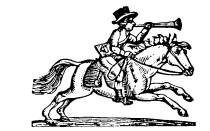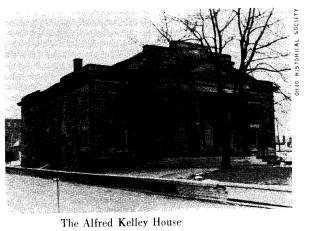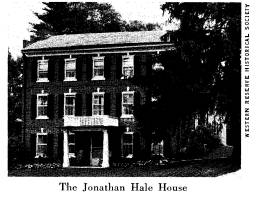Ohio History Journal
|
|
NEWS and NOTES THROUGH the efforts of a group of Colum- bus citizens, organized as the Kelley House Committee, Inc., and the Franklin County Historical Society, the famous Alfred Kelley mansion, located at 282 East Broad Street, has been carefully dis- mantled and removed to Franklin Park, where it is to be reconstructed and re- stored. At Franklin Park the stonework of each wall has been laid out on the ground in the same position it had vertically. Each of the three thousand stone blocks in the structure was marked to indicate its precise position. Some three hundred photographs were taken, and careful measurements and drawings were made, to record all exterior and in- terior architectural features. Walter L. Davis, construction super- intendent of the Ohio Historical Society, and Cyril H. Webster, who was on the staff of the Society as building superin- tendent of the Ohio State Museum before his retirement in 1958, supervised the dismantling and recorded the structural and architectural details. Members of the Columbus chapter of the American Institute of Architects served as con- sultants. The Alfred Kelley House was one of the largest and finest homes built in the Old Northwest at the height of the Greek Revival period. Erected in the 1830's, it was then the most imposing house in Columbus, and was until its dismantling one of the few examples of Greek Re- |
|
vival domestic architecture still standing in the heart of a large city. Its design is one of dignity and simplicity, featuring four Ionic porticoes and an unusual, if not unique, masking stepped parapet. The structure was built of Ohio standstone, probably brought to Columbus by canal boat. The house had many important his- torical associations. As the home of one of Ohio's ablest statesmen from 1838 to 1859, it was the center of hospitality for all important state and local political leaders. Sixty delegates to a convention in 1840 were entertained there at the same time. Alfred Kelley was one of the "fathers" of the Ohio canal system and supervised much of its construction. He became the architect of Ohio's financial and tax structure during his service in |
|
|
the general assembly and on the canal commission. At mid-century he turned his energies to the introduction of the railroad to Ohio. THE Ohio Historical Society will hold its seventy-seventh annual meeting at the Ohio State Museum, Columbus, Friday, April 27. The theme of the meeting is to be the Early American and Ohio Decorative Arts, and a special feature will be the opening of a new decorative |
|
NEWS AND NOTES 63 |
|
arts gallery at the Museum. The luncheon for members of the Society, guests, and officers and staff will be served in the galleries of the Arthur C. Johnson Audi- torium. RAYMOND S. Baby, curator of archaeology of the Ohio Historical Society, has been appointed by the Society for American Archaeology to participate in its abstract- ing program. As collaborator of the latter organization he is charged with preparing abstracts of all current pub- lished materials that concern the archae- ology of the Ohio area. The abstracts are to be published in the series known as Abstracts of New World Archaeology, be- ing prepared and issued by the Society for American Archaeology. Two volumes of this series have appeared to date. TWO new publications on the general sub- ject of Ohio and the Civil War have been issued by the Ohio Historical Society and the Ohio State University Press for the Ohio Civil War Centennial Commis- sion. They are Ohio Negroes in the Civil War, by
Charles H. Wesley, president of Central State College, and Ohio Forms an Army, by
Harry L. Coles, professor of history at Ohio State University. Other publications in this series, which is being prepared under the direction of the Advisory Committee of Historians of the centennial commission, are Ohio Troops in the Field, by Edward T. Downer; The Ohio Press in the Civil War, by
Robert S. Harper; and Ohio Politics on the Eve of Conflict, by Henry H. Simms. Future publications scheduled to appear during the coming year are Ohio's War Governors, by
William B. Hesseltine; Ohio Military Prisons in the Civil War, by Phillip R. Shriver; Ohio Agriculture During the Civil War, by Robert L. |
|
Jones; The Sherman Brothers and the War, by
Jeannette P. Nichols; Ohio Churches and Religion During the Civil War, by
Richard W. Smith; Cincinnati and the Civil War, by Louis L. Tucker; Vallandigham and the Civil War, by Frank L. Klement; Lucy Webb Hayes Views the Civil War, by Mrs. Ralph Geer; The Bounty System in Ohio Dur- ing the Civil War, by Eugene C. Mur- dock; Ohio Colleges in the Civil War, by G. Wallace Chessman; and Gunboats on the Ohio During the Civil War, by Robert Seager, II. The members of the Advisory Com- mittee of Historians are Thomas L. LeDuc, Oberlin College; Paul McStall- worth, Central State College; Paul I. Miller, Hiram College; Eugene C. Mur- dock, Marietta College; Virginia B. Platt, Bowling Green State University; James H. Rodabaugh, Ohio Historical Society; Robert Seager, II, Denison University; Phillip R. Shriver, Kent State University; Henry H. Simms, Ohio State University; Duane D. Smith, University of Toledo; H. Landon Warner, Kenyon College; Harris G. Warren, Miami University; Harvey Wish, Western Reserve Univer- sity; and Everett Walters, Ohio State University, chairman. The publications may be purchased or ordered from the Ohio Historical Society, 1813 North High Street, Columbus 10, Ohio. WILLIAM T. Utter, professor of history at Denison University, Granville, since 1929, died suddenly in a Newark, Ohio, hos- pital, January 12, 1962. Dr. Utter is re- membered as a contributor to and warm supporter of the work of the Ohio His- torical Society. He was the author of The Frontier State, 1803-1825, which was Volume II of the six-volume History of the State of Ohio, published by the |
|
64 OHIO HISTORY |
|
Society between 1941 and 1944. In the early 1950's he served as a consultant historian to the Society on improvements at Zoar, Adena, and the William T. Sher- man Birthplace. His most recent major publication was a book entitled The Story of an Ohio Village, a history of Granville issued in 1956. At the time of his death he was serving as chairman of the Ohio His- torical Advisory Committee of the Gov- ernor's Committee for Commemorating the Sesquicentennial of the War of 1812. Dr. Utter was the recipient in 1957 of an honorary life membership in the Ohio Historical Society. THE annual meeting of the Ohio Academy of Medical History will be held in Cleve- land, Saturday, April 28, 1962. The morning session is scheduled at the West- ern Reserve Historical Society, the lunch- eon and afternoon session at "Gwinn," the former Mather estate, located on the shore of Lake Erie at 12407 Lake Shore Boulevard. THE Historical and Philosophical Society of Ohio, Cincinnati, has announced plans for a new building. For many years housed in a section of the University of Cincinnati Library, it will erect its new structure as an addition to the Cincinnati Art Museum. The society will house its valuable collections in air-controlled sec- tions of the new quarters, enjoy modern reading rooms and offices, and have access to lecture hall and exhibition facilities. The January issue of the Bulletin of the Historical and Philosophical Society is a special edition devoted to the subject "Germany and Cincinnati." Among its nine articles and notes are an article on "The Germans of Cincinnati," by Carl Wittke, vice president of Western Re- serve University, another on "German |
|
Philosophy in Nineteenth Century Cin- cinnati," by Loyd D. Easton, chairman of the department of philosophy at Ohio Wesleyan University, and a third on "Some Architectural Aspects of German- American Life in Nineteenth Century Cincinnati," by Carl M. Becker, associate professor of history at Sinclair College, Dayton, and William H. Daily, a Dayton architect. THE Jonathan Hale Homestead, a museum of the Western Reserve Historical Society located near Peninsula, Ohio, is the sub- ject of a book recently published by the society. Written by John J. Horton, an |
|
|
associate for research of the society, the 160-page volume is entitled The Jonathan Hale Farm: A Chronicle of the Cuyahoga Valley. Jonathan Hale came from Connecticut to the Western Reserve in 1810. There he settled on the farm, which remained in the possession of the Hale family until 1956. In that year the Western Reserve Historical Society inherited the property from Miss Clara Belle Ritchie, who in- structed the society in her will to "take the necessary steps to establish the Hale Farm and buildings thereon as a museum for the display of books, paintings, furni- ture, household goods, farm and house- hold implements, china, silver, plate, ornaments, and similar objects, belong- |
|
NEWS AND NOTES 65 |
|
ing to the period and culture of the Western Reserve." The Hale house, a large three-story brick structure, built about 1827, has been restored and furnished in period by the society and opened to the public. Open also are the old sheep barn, which houses a museum of tools and imple- ments and methods of farming, and the Forge Barn, which is a museum on the skills and crafts of the early settlers of the Western Reserve. TWO significant research projects in Ohio history were given financial assistance by the American Association for State and Local History at its meeting in Washington, D. C., December 29, 1961. They were a study entitled "Internal Im- provements and Economic Change in Ohio, 1820-1860," by Harry N. Scheiber, assistant professor of history, Dartmouth College, and "A History of the Society of Separatists of Zoar," by Edgar B. Nixon, editor, the Franklin D. Roosevelt Library. Working under a Social Science Re- search Council Fellowship, Dr. Scheiber spent the year 1959-60 pursuing his re- searches for his study in the collections of the library of the Ohio Historical So- ciety. Dr. Nixon, a former resident of New Philadelphia and a descendant of Zoarites, has also worked in the Society's library in its extensive holdings of Zoar materials. A total of ten grants were made by the American Association for State and Local History at its December meeting. Such grants are made each year by the association as a part of its program to stimulate research and publication in state and local history. THE Fifth National Assembly for the centennial commemoration of the Civil War will meet in Columbus, May 4-5, |
|
1962. Invited to Ohio by the Ohio Civil War Centennial Commission and the Ohio Historical Society, the assembly will bring to the state capital the officers of the national Civil War Centennial Commission, representatives of state com- missions and historical societies through- out the country, and the nation's leading Civil War historians. Heading the federal delegation will be Allan Nevins, newly appointed chairman of the national commission, and James I. Robertson, Jr., the new executive di- rector. A feature of the program of the as- sembly will be the exhibition of "The General," the famous railroad engine of the Andrews Raid, popularly known as "The Great Locomotive Chase." The en- gine is being sent to Columbus by its owner, the Louisville and Nashville Rail- road. THE Western
Reserve Historical Society, Cleveland, announces that negotiations are under way for the removal and dona- tion of the Thompson Auto Album, a mu- seum of antique automobiles and air- planes, to the society. Thompson Ramo Wooldridge, Inc., now owns the collec- tion, which it displays in a building at East 30th Street and Chester Avenue, N.E., Cleveland. The architectural firm of Charles Bacon Rowley & Associates, Inc., which designed the Norton addition to the historical so- ciety's property several years ago, has been engaged to prepare plans for a sepa- rate building to house the auto album. The automobile museum was started in 1937 by Thompson Products, Inc., the predecessor of Thompson Ramo Wool- dridge, Inc., under the leadership of the firm's president, Frederick C. Crawford. EUROPEAN backgrounds
of western civili- zation are to be stressed in a fifty-five day, twelve-country, group study-tour of |
|
66 OHIO HISTORY |
|
Europe this summer, sponsored by Case Institute of Technology, Cleveland. The tour will leave New York by non-stop jet on June 30 and arrive in Amsterdam on July 1. From there it will visit his- toric and contemporary sites and cities in Holland, Belgium, Luxembourg, Ger- many, Switzerland, the principality of Liechtenstein, Austria, Italy, Greece, France, Monaco, and England. The tour instructor and supervisor will be Dr. Stanton Ling Davis, associate pro- fessor of history at Case Institute, who has directed summer study-tours in Europe for ten years. Case Institute will grant six semester hours of credit to those who wish it and meet the customary academic requirements. Teachers may use the tour and Professor Davis' accom- panying course in the European Back- ground of Western Civilization to meet in-service credit requirements. For further information write to Pro- fessor Stanton L. Davis, Department of Humanities and Social Studies, Case In- stitute of Technology, Cleveland 6, Ohio. THE Presbyterian
Historical Society, lo- cated in Philadelphia, announces that it will microfilm any paper or thesis which the society "considers to have sufficient interest for the study of the history of Presbyterianism or material relating to Presbyterianism." The microfilming of any item will be done at no expense to the author. "This service," the society states,
"is intended primarily for the reproduction of graduate theses, seminar papers, re- search projects, scholarly manuscripts, and other results of original research." The society proposes to make the micro- film available to any interested persons and institutions. Authors are urged to correspond with the society at 520 Witherspoon Building, Philadelphia 7, Pennsylvania, before send- ing manuscripts. |
|
THE American
Association for State and Local History, which has had its offices at the State Historical Society of Wis- consin, has moved to new quarters at 151 East Gorham Street, Madison 3, Wis- consin. The association will occupy the second floor of a brick building in a sec- tion of fine old houses, many of which have been converted to business use. It was formerly the residence of a prominent Madison family. The association, which was organized to promote interest and work in state and local history and to serve as a clear- ing house of information for historical societies and agencies, has greatly ex- panded its activities under its present di- rector, Dr. Clement M. Silvestro. The association issues a monthly magazine entitled History News and also Bulletins that are generally aimed at assisting local societies in organization, administration, and operations. Among the latest Bulle- tins are A
Guide to the Care and Admin- istration of Manuscripts, by Lucile M. Kane, and The Management of Small His- tory Museums, by
Carl E. Guthe. Membership in the association is open to all interested persons. It particularly welcomes local historical societies and their officers. THE National
Archives is issuing a series of small pamphlets to describe its various collections and explain its services to the American people. Of several that have particular interest for Ohioans are three entitled as follows: Pension and Bounty- Land Warrant
Files in the National Archives; Genealogical Records in the National Archives; and Age and Citizen- ship Records in the National Archives. For copies of these and other pamphlets, write to The National Archives, Wash- ington 25, D.C. |


